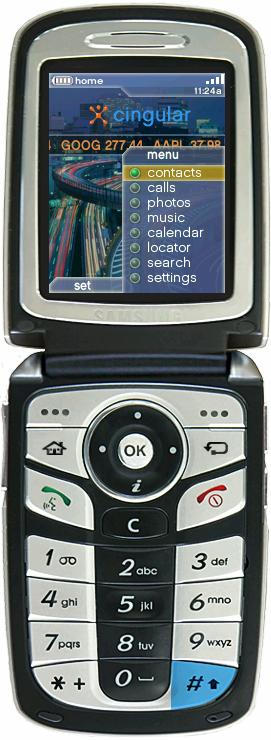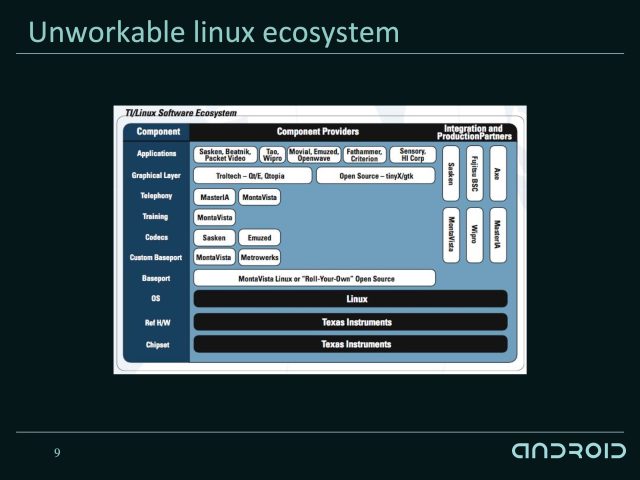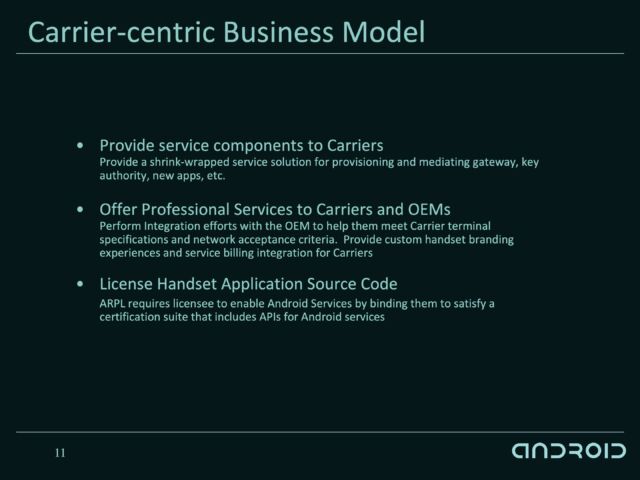
By mid-2005, Android was acquired and the future looked bright. But just six months earlier, things weren’t quite as rosy. In January of that year, the startup was desperate for cash and their main task was the same as for most startups: getting funding. After the pivot from a camera OS to an open source phone platform, they still had the daunting task of actually building a product, which meant they’d need more money to hire a large enough team to do the work.

So the company focused on three things. First, they needed a demo to show what was possible. Next, they needed to articulate their vision and create a pitch deck to help explain that vision. Finally, they needed to take the demo and the slide deck on the road to pitch their story to potential investors.
Demo time
The first job for Andy McFadden (known to the team as “Fadden”) when he joined was solidifying the demo, a prototype phone system that Brian Swetland and Chris White had been working on. It wasn’t actually functional (for example, it showed a stock ticker on the home screen which used a set of hard-coded symbols and stale data). But the demo represented a vision of what the product could be when it was actually implemented.
One of the apps that Fadden added to the demo was a simple calendar application. This early demo project would come back to haunt him. After many intervening years of working on things throughout the Android plat- form, he ended up helping out with the Android Calendar app. Time waits for no man... but calendar apps do.
The mobile opportunity
As the team honed their vision, they created a slide deck to explain it. These slides painted a picture of the opportunities that they saw for Android in the marketplace, as well as a picture of how Android would make money for the investors.
The slide deck in March of 2005 had fifteen slides, which was enough to capture the attention of VCs as well as Google.
The pitch deck got interesting by the second slide, which compared PC and phone markets. In 2004, there were 178 million shipments of PCs world- wide. During the same period, there were 675 million phones shipped; nearly four times as many units as PCs, but with processors and memory that were as capable as PCs were in 1998.
 The first slide of the pitch deck. The word ANDROID in that custom font remained the logo for the OS for many years after this startup phase.Chet Haase
The first slide of the pitch deck. The word ANDROID in that custom font remained the logo for the OS for many years after this startup phase.Chet Haase The number of mobile phones already dwarfed the number of PCs being sold in 2004, providing a huge opportunity for phones with more capable software.Chet Haase
The number of mobile phones already dwarfed the number of PCs being sold in 2004, providing a huge opportunity for phones with more capable software.Chet Haase
This potential in mobile hardware was a point that Dianne Hackborn, then at PalmSource and eventually on the Android team, was also thinking about. The mobile industry was ready to pop because there was finally enough power for there to be a real, capable computing platform: Dianne said, “You could see the writing on the wall. The hardware was getting more powerful, and the market was already bigger than PCs.”
The presentation also identified the problem of the growing cost of mo- bile software. The cost of hardware was going down, but that of software was not, making it a larger and larger proportion of the per-handset cost. But handset manufacturers were not experts in software platform development and didn’t have the skill set or interest in providing the increasing capabilities required to differentiate their software from that of their competitors.
An open opportunity
The second major point in the pitch deck was that there was a gap, and an opportunity, in the market for an open platform. That is, Android would be an operating system that was free and available to manufacturers through open source. Companies would be able to use and distribute this OS on their own phones, without being beholden to a software provider and without having to build it themselves. This open approach was something that was simply not available at that time.
Microsoft provided a proprietary OS that manufacturers could license and then port to their hardware. Symbian was primarily used by Nokia, with some uptake from Sony and Motorola. RIM had its own platform, which it used only for its own BlackBerry devices. But there was no alternative out there for manufacturers that wanted a capable smartphone without either building their own OS, putting significant effort into customizing an existing one, and/or paying a high licensing fee.

Even more problematic, the systems that were available failed to provide an ecosystem for applications. Symbian provided some of the core infra- structure for an operating system, but the UI layer was left as an exercise for the manufacturer, resulting in an application model for phones where apps written for one flavor of Symbian wouldn’t necessarily run on some other variation, even on phones from the same manufacturer.
The Java programming language, known in the server and desktop PC world as “write once, run anywhere,” could possibly have provided this kind of cross-device application capability, but Java ME fell far short of this in the mobile space. While it did provide at least the same language across devices (much as Symbian provided the same language of C++ for all of its implementations), Java ME addressed the wide variety of form factors and architectures in phones by providing different versions of the platform, called profiles. These profiles had different capabilities, so devel- opers needed to change their applications to run on different devices, and often that approach failed when capabilities were drastically different across devices.
Linux to the rescue!... Almost. Texas Instruments (TI) provided an open platform based on the Linux OS kernel. All manufacturers needed was Linux itself, reference hardware from TI, and then a huge host of other modules that manufacturers had to acquire, license, build or otherwise supply to create their own device. As Brian Swetland put it, “You could use TI’s OMAP chips to build a Linux phone. So you needed TI’s OMAP and then forty com- ponents from forty different vendors of middleware. You put all these together and you integrated them all and then you’d have a Linux phone. And that was just absurd.”

Android wanted to provide the world’s first complete open handset plat- form solution. It would be built on Linux, like TI’s offering, but would also provide all of the necessary pieces so that manufacturers would have only one system to adopt in order to build and ship their devices. Android would also provide a single programming model to application developers, so that their apps would work the same across all devices on which the platform ran. By having a single platform that worked across all devices using it, Android would simplify phones for both manufacturers and developers.
Making money
The final part of the pitch (and the most important part, for the VCs they were pitching to) was how Android was going to make money. The open source platform described in the slides is essentially what the Android team eventually built and shipped. But if that was all there was, the company would not have been worth funding for VCs. Developing and giving away an open source platform sounds great from a save-the-world standpoint, but where’s the payoff? Where’s the upside for investors? That is, how did Android plan to make money off of a product that they planned to simply give away? Venture capitalists fund companies that they hope will make more (far more) than their investment back.
The path to revenue was clear for the other platform companies in the game. Microsoft made money by licensing its platform to Windows Phone partners; every phone sold contributed a per-device cost back to Microsoft. RIM made money both on the handsets they sold as well as the lucrative service contracts that their loyal enterprise customers signed up for. Nokia and the other Symbian adopters made money by selling the phones that they manufactured with variations of that operating system. Similarly, all of the other handset manufacturers funded their own software development through the revenue generated by the phones they sold.
So what was Android’s play that would fund the development of this awe- some platform that they had yet to build and which they would give away free to other manufacturers to build their own devices?
Carrier services.
Carriers would provide applications, contacts, and other cloud-based data services to their customers for Android-based handsets. The carriers would pay Android for providing these services. Swetland explained: “Rather than running and hosting the services [like Danger did for its Hiptop phones], we would build the services and sell them to the carriers.” (In fact, the system that the team eventually built and shipped stayed true to the vision laid out in the pitch deck, except for this part about revenue from carrier services, which went away entirely.)

Pitching the dream
The Android team pitched to a few VCs, mostly on the East Coast, far away from Silicon Valley. As Rich Miner put it, “Andy had been up and down Sand Hill Road with the Android pitch as a Camera OS and had already got a bunch of ‘No!’s, including from Red Point where he was the EIR [Entrepre- neur in Residence]. Part of my joining up was to say, ‘I have a bunch of East Coast VCs and other people I can introduce you to.’ So we started going to mostly new people who hadn’t heard of Android before.”
In parallel with these VC meetings, the team was also meeting with Google. In early January, Larry Page asked Andy to come to Google for a meeting. Larry was a huge fan of his T-Mobile Sidekick (the Danger Hiptop) phone, which Andy’s previous company had made, so he wanted to talk to Andy about the mobile space. Andy called Nick Sears, who was still working at T-Mobile, and asked him to come to the meeting as well.
It was a small meeting, with just Andy and Nick from the Android side and Larry, Sergey Brin, and Georges Harik (an early Google employee) from the Google side. Nick remembered the meeting as very casual, but also that Google was clearly interested in what Andy and Android were up to. “That meeting started out with Larry saying the Sidekick’s the best phone that’s ever been done. Larry very much wanted to see an even better phone get made, and he knew that’s what Andy and the group of us were working on. At the end of that meeting they said, ‘We’d like to help you guys.’”
That meeting was encouraging, but nothing substantive came out of it. In fact, Andy wondered whether they were just using the meeting as a way to pick Andy’s brain about Danger, the company he’d founded and left back in 2003. He thought that Google might have been interested in purchasing Danger.
Meanwhile, the team continued pitching to VCs. Then in March, they went to Google for another meeting. This time, they showed a demo and shared more of their plans. Nothing significant happened at that meeting either, but Google made it clearer that they wanted to help the startup.
The team was also meeting with potential manufacturing partners at this time. They took a trip to Korea and Taiwan to visit Samsung and HTC. The meeting with Samsung started with the CEO of the mobile phone unit, K.T. Lee, saying he’d missed his chance with Danger and didn’t want to see that happen again, so he was interested in getting on board with Android. Nick described the meeting: “K.T. Lee told his team to make it happen, so we thought it was a done deal. But then we met with his team of 10+ mid-level managers, who said, ‘Who is going to build your OS?’ When we said ‘Brian,’ they laughed. They had 300 people working on their own OS.”
Samsung asked the team if they were dreaming. Nick said, “‘No, really, Brian and a few other people are going to build the OS.’ They asked how this would be possible and we responded that not only is it possible, but he already did it on Sidekick.”
After the business meetings, Samsung hosted a dinner to celebrate the new partnership. But the Android team later learned the deal was contingent upon securing an order from a carrier, which Nick admitted, “wasn’t really a deal at all. It took about 18 months to convince T-Mobile to become our Android launch partner.”
The team didn’t come away with a deal, but they did get a device name from it. When they later picked the device that would become the G1, they gave it the code name “Dream” in memory of that meeting.
From Korea, the team flew to Taiwan, where they met with the CEO of HTC, Peter Chou. Nick remembered the meeting: “Peter mentioned some- thing about exclusivity for our first device, which Brian overheard. By the time we got back to our hotel room, Swetland had threatened to resign because ‘I didn’t join Android to become another Danger.’ I was concerned because Brian was so critical to our success, but when I saw him the next day everything was fine.”
(Swetland said, “I don’t recall the discussion, but certainly believe it could have happened.” His memory of Danger was fresh and strong at that time. The dynamic at Danger of being beholden to the carrier and manufacturer for product decisions was not something he wanted to repeat. He was strongly in favor of Android’s vision for an open and independent platform. He threatened to resign several times during his time on the Android team over decisions that would have resulted in a closed platform.)
The team continued pitching to VCs, and found some success. Charles River Ventures and Eagle River Holdings were both interested. While they were waiting on paperwork from those firms, Google called them in for a third meeting.
This time, there were more people in the room, and Google was ready to talk specifics. Andy and his team had assumed they were coming to give an update on the company’s progress since the last meeting. But in the middle of the presentation, Nick remembered, “They just said, ‘Let us interrupt you there. We just want to buy you.’”
Google turned what Andy’s team thought was a meeting of Android pitching to Google into a meeting in which Google was pitching to them in- stead. Google said if Android allowed itself to be acquired, it would do much better than it would otherwise. Instead of having to deal with the require- ments of venture capitalists, and having to charge customers and carriers for specialized services, they could just give the OS away to the carriers for free. In fact, it would be even better than free: Google had revenue from search that they might be able to share with carriers. So rather than having to sell carriers on something, they’d be able to form partnerships with them. Nick remembered that it was a powerful argument for getting carriers on board: “We were actually going to help them make money by doing a partnership deal with us.”
The team from Android was game for joining Google, but there were still many details to be figured out. In the meantime, in mid-April, they got term sheets from both Eagle River and Charles River and decided to go with the Eagle River deal. The Google deal was far from final, but had entered negoti- ations in early May, so they added a carve-out in the term sheet, to account for the possibility that they’d do something with Google instead.

The acquisition
“They bought a team and a dream. I’d like to believe we executed pretty well on it.”
–Brian Swetland
When Android met with Google, Larry Page observed that it would make sense for Google to acquire the small company, to help them build a platform that would enable Google to enter the mo- bile market.
While both parties agreed in principle, there were many details to be ironed out. Nick recalled two large issues that Android needed to resolve with Google. The first was money: they needed to agree on the valuation of the company and how they would be paid, both initially and in ongoing mile- stone payments after the team joined. The second issue was commitment: Android wanted to make sure that they would actually get to accomplish the original goal and not just get sucked up into the larger company and forgotten. They needed Google to agree to support Android’s efforts after the acquisition and provide internal support on an ongoing basis.
The negotiations began in the Spring of 2005. But Rich Miner had a problem: a family vacation conflicted with these time-sensitive meetings. He ended up doing both in parallel, calling in to the meetings from a sailboat in the British Virgin Islands. “I had to find ports that had mobile phone coverage. I’d have to have the boat with everybody off on the beach enjoying themselves during these two-hour negotiation phone calls.
“One of the things we were concerned about was, ‘This isn’t strategic to Google. You guys haven’t even started focusing on WAP or any mobile stuff. We think this is going to be a lot of work, require resources. What happens if you don’t want to do this? How do we know we’re going to get the resources we need to be successful?’”
Larry Page suggested they go talk with Jonathan Rosenberg, a Google executive in charge of product and marketing. Rich remembered his advice: “‘Google’s different from other companies. A lot of other companies, when projects aren’t going well, they throw a lot of resources at it. At Google, we like to give resources to things that are going well. So if you do what you’re going to do and you’re executing, you’ll get more resources.’ That was, in essence, his Leap of Faith talk; why we should, if we believe in ourselves, do this because we’ll get the resources if we’re executing.”
The Android team came back to the table (and the boat), hammered out a deal, and the team started at Google on July 11, 2005.
A few weeks after the Android team started at Google, they were again presenting the pitch deck. This time, it was at an internal meeting at Google, pitching to a group of executives. Andy and others were showing what this newly acquired team was planning to do. Swetland described the meeting: “We showed the demo we had. Andy was running through the deck. I re- member when he got to the monetization thing, Larry cut him off and said ‘Don’t worry about that. I want you guys to build the best possible phone and we’ll figure out the rest later.’”
Chet Haase worked at several Silicon Valley tech companies, helping to create many software products you've never heard of. In 2010, he joined the Android engineering team at Google and watched Android rise from the bottom of the smartphone field to where it is today. it's been... interesting. (Haase is also a multiple-time author and a frequent part of the Android Developers Backstage podcast.)
"Android" - Google News
August 13, 2021 at 06:15PM
https://ift.tt/3iIgIUj
Excerpt: How Google bought Android—according to folks in the room - Ars Technica
"Android" - Google News
https://ift.tt/336ZsND
https://ift.tt/2KSW0PQ
Bagikan Berita Ini














0 Response to "Excerpt: How Google bought Android—according to folks in the room - Ars Technica"
Post a Comment